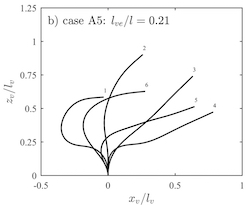ABSTRACT
The hydrodynamic drag generated by seagrass meadows can dissipate wave energy, causing wave decay. It is well known that this drag depends on the relative motion between the water and the seagrass blades, yet the impact of blade motion on drag and wave energy dissipation remains to be fully characterized.
This experimental study examines the impact of blade motion on wave decay by concurrently recording blade posture during a wave cycle and measuring wave decay over a model seagrass meadow (dynamically similar to Zostera marina). We find that blade flexibility leads to significantly lower drag and wave decay relative to theoretical predictions for rigid, upright blades.
To quantify the impact of blade motion on wave decay, we propose the use of an effective blade length, lve, defined as the rigid blade length that leads to equivalent wave energy dissipation. We estimate lve directly from images of blade motion. Consistent with previous studies, our results indicate that the effective blade length depends on a dimension less parameter that describes the relative magnitude of the hydrodynamic drag and the restoring force due to blade rigidity.
As the hydrodynamic forcing increases, the blades exhibit greater motion. Greater blade motion leads to smaller relative velocities, reducing drag and wave energy dissipation (i.e. smaller lve). We identify scaling laws that predict effective wave length and wave decay over a range of seagrass blade density, wave period, wave height, and water depth scaled from typical field conditions.
DOI: 10.1002/2017JC012731








